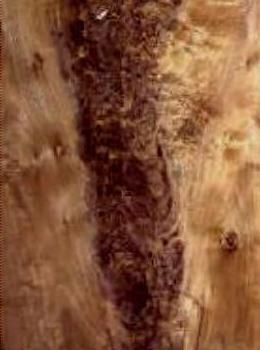- HOME
- ABOUT VENEER
- DOMESTIC
- EXOTIC
- BURL/CROTCH
- DYED VENEER
- PROJECTS
- CABINETS
- ACCESSORIES
- DOORS
- PANELS
- FIXTURES
- FURNITURE
- CUE COMPONENTS
- ON SALE
Walnut Crotch
As we all know, crotch Walnut is created where a branch intersects with a tree's trunk and/or when there is a double trunk. Wood fibers weave together to strengthen the limbs or branch involved forming the crotch and feather appearance. The term feather is used because the pattern created by this natural process resembles a feather. The term rat tail is sometimes used to describe the heart of crotch wood nearest to the center of the trunk. As the crotch works its way to the outer edges of a tree trunk, its heart widens, eventually turning into swirl. Keep in mind that when used in an architectural application, the appearance of crotch is upside down from the way it's actually formed. Bark pockets that interupt its sequence are common in Walnut crotch. So, what may have started out as a 4-foot long crotch, can easily end up as a 20-inch crotch with perhaps a 10-inch crotch on the other end of the bark pocket. This is just one scenario that helps push up the price of Walnut crotch. A mill pays for a certain amount of cubic footage, doesn't get it and then has to do additional clipping in order to grade, which can add to their investment and the retail price. Need I say, that nice Walnut crotch is getting expensive, but worth it? We have a large Walnut crotch in stock.
Walnut Crotch
